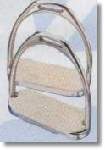
Fillis Stirrup Irons
$29.95
| |
|
Rotational Grazing
Produced by the Maryland Department of Agriculture's Office of Resource Conservation
|
Nothing is harder on grass than constantly being grazed down to the roots, and horses are notorious overgrazers. Grass needs to be rested occasionally to allow it to rejuvenate. This pasture management method, called rotational grazing, offers your pastures their best chance at rejuvenation. Rotational grazing also helps keep weeds at bay and combats soil compaction by promoting root growth.
Rotational grazing requires that all animals be removed from a pasture when the grass is grazed below two inches. The pasture then sits empty until the grass has grown above six inches. For a rotational grazing system to work, though, you must be able to rest each pasture up to a month at a time. Larger pastures should be subdivided as much as possible to encourage the horses to graze the grass more evenly than they would normally. The smaller your pastures, the more intensively you'll need to manage them.
But a rotational grazing plan involves more than just moving horses from pasture to pasture. To get the most out of your land, follow these steps:- Have your soil analyzed to determine its fertility level and pH, and have the pastures limed and fertilized accordingly.
- Have your fields aerated, if possible, once a year. Seed bare areas each fall.
- Determine how many times you can subdivide each pasture. There is no magic number when it comes to horses. You'll need to take into account the activity level of each herd, and how quietly they interact. For instance, a sedate herd of geldings can be squeezed into a smaller space than can a group of youngsters or a mixed-sex group. You don't want the horses to feel too crowded or they can become aggressive toward each other. If you're not sure how much crowding your horses will tolerate, start slow by subdividing a large pasture once. Test that for a couple of weeks, and if all goes well, try subdividing it again.
- Designate one of the subdivisions as a sacrifice area-a pasture or paddock that you sacrifice for the sake of the other pastures. You'll put the horses in the sacrifice area whenever the ground is wet or if none of your pastures has regrown to more than six inches. A sacrifice area should be on the best-drained part of your land and as far from a stream or low area as possible. A sacrifice area's surface can be anything that won't wash away, from grass (or earth) to bluestone to wood chips.
- Subdivide your pastures. Because you may need to move the interior fencing, it should be portable, such as horse tape and step-in posts. For highest visibility, use at least two strands of wide, white tape.
- Start your horses in the pasture that is in the best shape. Monitor the grass length, and move the horses when the majority of grass has been grazed down to 2 to 3 inches in height. The amount of time spent in each pasture will vary depending on the time of year.
- Each time you move the horses, drag the newly vacated pasture to break up and spread out manure.
- Move the horses once the grass gets short. If the next pasture hasn't regrown to six inches, put the horses in the sacrifice area until the pasture is ready.
- Occasionally clip the pastures no shorter than six inches to prevent weeds from going to seed and to keep the grass palatable, which promotes even grazing.
Rotational grazing allows your pastures to stay green, which is healthier for your pastures and your horses. As a bonus, you should see a decrease in your feed bill as well.
For more information on pasture management, contact the local office of the Natural Resources Conservation Service (NRCS), Maryland Cooperative Extension (MCE), or Soil Conservation District (SCD).
Produced by the Maryland Department of Agriculture's Office of Resource Conservation.
|
|
|
|
|
|
|



